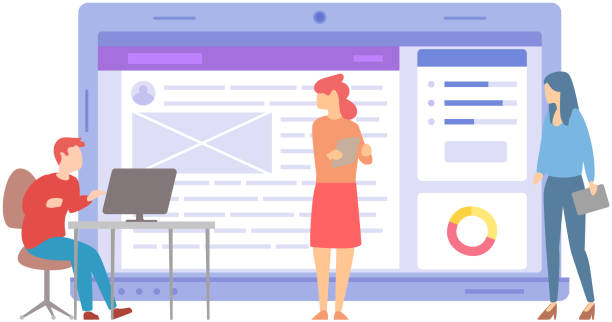Introduction to Secure Website Design and Its Importance in the Digital World

In the current era, where everything is moving towards digitalization, #WebsiteSecurity and #SecureWebsiteDesign are of vital importance.
Every website, from a simple personal blog to a large e-commerce platform, is exposed to various security threats.
A breach of a website can not only lead to the loss of sensitive data but also severely damage business reputation and credibility.
This section provides an explanation of the concept of secure website design and why its importance is growing in today’s cyber space.
The goal of secure website design is to create an online environment where user and business information is protected in the best possible way.
This includes protection against cyber attacks, prevention of unauthorized access, and ensuring data integrity.
Without adhering to the basic principles of secure website design, your website will always be an easy target for attackers.
Investing in web security is not just an expense, but an investment in the future and sustainability of your business.
Does your company’s website perform as it should for your brand? In today’s competitive world, your website is your most important online tool. Rasaweb, a specialist in professional corporate website design, helps you to:
✅ Gain customer credibility and trust
✅ Convert website visitors into customers
⚡ Get a free consultation!
Common Web Security Threats and How to Identify Them

To achieve secure website design, one must first become familiar with the types of threats that target websites.
#CyberAttacks today have become much more complex and diverse, encompassing a wide range of issues including SQL injection, Cross-Site Scripting (XSS), Cross-Site Request Forgery (CSRF), Distributed Denial of Service (DDoS) attacks, and many more.
This specialized section of the article explains and guides on identifying these threats.
For example, SQL injection occurs when an attacker attempts to access or modify database data by inserting malicious code into website inputs.
Or, in an XSS attack, malicious code is injected into web pages to gain access to user information.
Identifying these attacks is usually possible through continuous monitoring of server logs, using automated security scanners, and performing regular penetration tests.
A deep understanding of these threats is the first step towards building an impenetrable website and correctly implementing the principles of secure website design.
This analytical approach helps you identify and fix potential weaknesses in your system before attackers discover them.
Secure Coding Principles for Secure Website Design

Secure coding is the #foundation of any #securewebsitedesign and a reliable one.
This educational and specialized section provides key guidelines for developers to prevent common vulnerabilities in their code.
Using secure functions and frameworks, thorough validation of user inputs, and proper error handling are among the important principles in this area.
For example, user input data should never be used directly in database queries or HTML outputs without proper validation and filtering.
This can lead to attacks such as SQL injection or XSS.
Also, using Prepared Statements when working with databases is an effective method to prevent SQL injection.
Proper session management and strong password encryption are other vital aspects of secure coding.
Secure website design requires a comprehensive approach from the very beginning of the development process, not just after completion.
Below is a table of some key secure coding principles:
| Principle | Explanation | Importance in Secure Website Design |
|---|---|---|
| Input Validation | Thoroughly checking and filtering all user inputs before processing. | Prevents SQL injection, XSS, and Directory Traversal attacks. |
| Error Handling and Logging | Displaying general error messages to the user and logging error details in secure logs. | Prevents sensitive information disclosure and helps identify attacks. |
| Data Encryption | Using strong encryption algorithms for sensitive data in transit and at rest. | Protects confidential information from unauthorized access. |
| Session Management | Using secure methods for managing user sessions (e.g., random tokens). | Prevents session hijacking and user impersonation. |
Database Security: The Backbone of a Secure Website

The database is the beating heart of every website, storing critical user information and site content.
Therefore, #DatabaseSecurity is one of the #mostessential pillars in the secure website design process.
A successful database breach can lead to catastrophic consequences, including identity theft, disclosure of confidential information, and even complete data destruction.
Specialized guidance in this area includes applying the principle of Least Privilege for database users, regular updates of database software, encryption of sensitive data at rest and also in transit.
For example, user accounts with full access (such as root or sa) should not be used for website connections to the database.
Additionally, sensitive information such as user passwords should be stored as salted hashes, not as plain text.
Regular and secure backups of the database are also a vital step for data recovery in case of a disaster.
Database security is not limited to coding; it also includes proper server configuration, firewalls, and network protocols, all of which contribute to the overall robustness of website security.
This explanatory approach highlights the importance of every aspect of database security to ensure a secure website design.
Are you dissatisfied with the low conversion rate of visitors to customers on your e-commerce site?
With professional e-commerce website design by Rasaweb, solve this problem permanently!
✅ Increase visitor-to-customer conversion rate
✅ Create an excellent user experience and build customer trust
⚡ Get a free consultation
SSL/TLS Security Protocols and Their Role in Secure Website Design

#SSL/TLS protocols play a #fundamental and undeniable role in secure website design and building trust between users and websites.
These protocols are responsible for encrypting communications between the user’s browser and the website server, ensuring that transmitted information (such as username, password, and credit card details) remains safe from any eavesdropping or tampering by third parties.
The use of HTTPS, which is built on SSL/TLS, is today not just a security feature but a standard for all websites.
Modern browsers mark websites that do not use HTTPS as “insecure” and warn users, which can harm website credibility.
Furthermore, search engines like Google prioritize HTTPS-enabled websites in search rankings, which is an important aspect of SEO and traffic generation.
The correct installation and configuration of an SSL/TLS certificate and ensuring its validity is a crucial step in implementing secure website design.
This is a vital guideline that must be considered.
These protocols, by creating a secure communication channel, protect information in transit and provide assurance to users that their data remains confidential and intact while moving across the internet.
User Authentication and Access Management: A Barrier Against Intrusion

One of the most important pillars of secure website design is strong #authentication and #useraccessmanagement (IAM) systems.
These systems determine who can access the website and what actions they can perform within it.
Strong and unique passwords, the use of two-factor authentication (2FA), and the implementation of account lockout mechanisms after multiple failed attempts are among the best educational practices in this area.
Two-factor authentication significantly enhances account security, because even if a password is compromised, the attacker still needs the second factor (such as a code sent to the phone).
Additionally, implementing password complexity policies that require users to choose long passwords including a combination of uppercase and lowercase letters, numbers, and symbols is crucial.
This is a practical and very important guide for any website that aims to be secure.
Beyond authentication, access management is also important; meaning users should only have access to resources they need to perform their tasks (principle of least privilege).
Continuous monitoring of failed login attempts and detecting suspicious patterns can indicate Brute Force attacks and significantly help strengthen website security.
Security Updates and Regular Audits: Keys to Sustained Security

A critical and often overlooked aspect of secure website design is #regularupdates and #periodicsecurityaudits.
No website remains completely impenetrable after launch; cyber threats are constantly evolving, and new vulnerabilities are discovered.
This analytical and news-focused section emphasizes the vital importance of these two factors in maintaining the sustained security of a website.
Keeping the CMS core (such as WordPress, Joomla), plugins, themes, and all server software (such as PHP, Apache, Nginx, MySQL) up-to-date is essential for patching known security holes.
Delays in updates can make your website vulnerable to attacks that exploit public vulnerabilities.
Regular security audits, including automated scans and manual penetration tests, help identify weaknesses and misconfigurations before attackers can exploit them.
This process should be performed periodically, not just once. Below is a table of key aspects of security auditing:
| Audit Aspect | Explanation | Why is it important? |
|---|---|---|
| Vulnerability Scanning | Using automated tools to find known vulnerabilities in code and infrastructure. | Rapid identification of common weaknesses. |
| Penetration Testing (Pen Test) | Simulating real attacks by specialists to discover more complex vulnerabilities. | In-depth security review and discovery of weaknesses that scanners may miss. |
| Log Review | Regularly checking server and application logs for signs of suspicious activity. | Detection of ongoing attacks or unsuccessful intrusion attempts. |
| Configuration Review | Ensuring secure configuration of the server, database, and web software. | Closing intrusion paths resulting from default or weak settings. |
Up-to-date security information and continuous audits form the backbone of a stable secure website design and help maintain website security against emerging threats.
Web Application Firewalls (WAFs) and Other Advanced Security Tools

To further strengthen secure website design, the use of #advancedsecuritytools such as #WebApplicationFirewalls (WAFs) is essential.
WAFs act as a protective layer between the internet and your web server, analyzing incoming traffic to identify and block malicious attacks.
These tools can provide protection against a wide range of attacks including SQL injection, XSS, and Denial of Service (DoS/DDoS) attacks.
This is expert guidance that can significantly increase your website’s security level.
In addition to WAFs, other tools also help in enhancing website security, including Intrusion Detection Systems (IDS) and Intrusion Prevention Systems (IPS), which are used respectively for detecting and preventing suspicious network activities.
Also, Security Information and Event Management (SIEM) solutions help collect and analyze security logs from various sources to identify and respond to threats more quickly.
Correct configuration of these tools and continuous monitoring of their output are vital for maximizing their security potential.
These tools, especially for high-traffic websites or those processing sensitive information, are an integral part of a comprehensive and secure website design and create additional layers of defense against complex attacks.
Are you tired of your company’s website not being seen as it deserves, losing potential customers? Solve this problem permanently with professional and effective website design by Rasaweb!
✅ Increase brand credibility and gain customer trust
✅ Attract targeted sales leads
⚡ Call us now for a free consultation!
Incident Response Planning and Data Recovery After an Attack

Even with the best #securewebsitedesign approaches and the strongest preventive measures, no website is completely immune to attack.
Therefore, having a #definedplan for incident response and disaster recovery after an attack is of paramount importance.
This analytical and guiding section emphasizes the necessity of preparing for worst-case scenarios.
An incident response plan should include precise steps for identifying the attack, containing it, eradicating the threat, recovering systems, and finally, learning from the incident.
Speed and efficiency in these stages can significantly reduce the extent of damage.
For example, in the event of an attack, the security team must be able to quickly identify the source of the intrusion, cut off the attacker’s access, and fix the exploited vulnerability.
The data recovery plan must also include regular and reliable backups of all data and configurations so that in case of data loss, the system can be restored to its state before the attack.
These backups should be stored in a secure location separate from the main server.
Regular preparation and practice of these plans can make the difference between a minor disruption and a major disaster, ensuring the sustained website security of your website.
The Future of Secure Website Design and Emerging Challenges

The world of #securewebsitedesign is constantly evolving, and with the emergence of #newtechnologies, new challenges also arise.
This thought-provoking and analytical section examines future trends and challenges that web security professionals will face in the coming years.
With the expansion of the Internet of Things (IoT), Artificial Intelligence (AI), and Cloud Computing, the attack surfaces for websites and web applications are increasingly expanding.
While AI can help enhance security, it can simultaneously be used by attackers for more complex and automated attacks.
Protecting data in cloud environments, where security responsibility is shared between the cloud service provider and the user, is also a significant challenge.
Microservices and Serverless architectures also demand new approaches for secure website design.
Furthermore, Identity-based attacks and the use of deepfake for social engineering are among the threats that require innovative solutions.
Can current security systems keep pace with this rate of change? This is a fundamental question that shapes the future of website security and necessitates proactive and adaptive approaches for secure website design.
Frequently Asked Questions
| Row | Question | Answer |
|---|---|---|
| 1 | What is secure website design? | Secure website design is a process in which websites are built with security measures in mind from the initial stages of development to protect against cyber attacks, unauthorized access, and data loss. |
| 2 | Why is secure website design important? | Site security is crucial for maintaining user trust, protecting sensitive information (personal and financial), preventing damage to brand reputation, and complying with privacy and security regulations (such as GDPR). A security breach can lead to financial and legal damages. |
| 3 | What are the most common cyber attacks a website faces? | Some of the most common attacks include SQL Injection, Cross-Site Scripting (XSS), Distributed Denial of Service (DDoS), Brute Force, and Credential Stuffing attacks. |
| 4 | What is SQL Injection and how to prevent it? | SQL Injection is a type of attack where an attacker attempts to manipulate the database or extract information by injecting malicious SQL code into site inputs. To prevent it, one should use Prepared Statements/Parameterized Queries, ORM (Object-Relational Mapping), and strict input validation. |
| 5 | What is Cross-Site Scripting (XSS)? | XSS is a type of attack where an attacker injects malicious scripts (usually JavaScript) into web pages, which are then executed by other users’ browsers. This can lead to the theft of cookies, session information, or alteration of the website’s appearance. |
| 6 | How can Brute Force attacks on login pages be prevented? | To prevent Brute Force attacks, one should use CAPTCHA, limit the number of failed login attempts (Account Lockout), two-factor authentication (2FA), and use complex and long passwords. |
| 7 | What is the role of HTTPS in website security? | HTTPS encrypts the communication between the user’s browser and the website server using SSL/TLS. This prevents eavesdropping, tampering, or forging of information during transmission and increases user trust. |
| 8 | What is the importance of Input Validation in security? | Input validation is the process of checking and sanitizing data entered by the user. This prevents the injection of malicious code, XSS attacks, SQL Injection, and other vulnerabilities, ensuring that the data conforms to the expected format. |
| 9 | Why is regular updating of website systems and software essential? | Regular updating of the operating system, CMS (like WordPress), plugins, themes, and libraries used fixes known security vulnerabilities. Hackers often exploit weaknesses in outdated software to gain unauthorized access. |
| 10 | What role do regular backups play in secure website design? | Regular and tested backups of website data (database and files) provide a critical layer of defense against data loss due to cyber attacks, human errors, or hardware failures. This allows for quick website recovery in case of a disaster. |
And other services of Rasa Web Advertising Agency in the field of advertising
Smart Custom Software: A fast and efficient solution to improve SEO ranking with a focus on SEO-driven content strategy.
Smart Advertising Campaign: Revolutionize click-through rate increase with the help of user experience customization.
Smart Customer Journey Map: A fast and efficient solution for increasing website traffic with a focus on SEO-driven content strategy.
Smart Google Ads: A new service to increase website traffic through user experience customization.
Smart Sales Automation: A professional solution for increasing click-through rates with a focus on using real data.
And over hundreds of other services in the field of online advertising, advertising consulting, and organizational solutions
Online Advertising | Advertising Strategy | Advertorials
Sources
Secure Website Design and Its Tips
10 Important Website Security Tips
Comprehensive Website Security Checklist
Guide to Fixing Website Vulnerabilities
? Lead your business to digital success with Rasaweb Afarin Digital Marketing Agency. From custom website design to SEO optimization and advertising campaign management, we are with you every step of the way to ensure a powerful and impactful online presence. Contact us for a consultation and to begin your business’s digital transformation.
📍 Tehran, Mirdamad Street, Next to Central Bank, Southern Kazeroun Alley, Ramin Alley, No. 6



